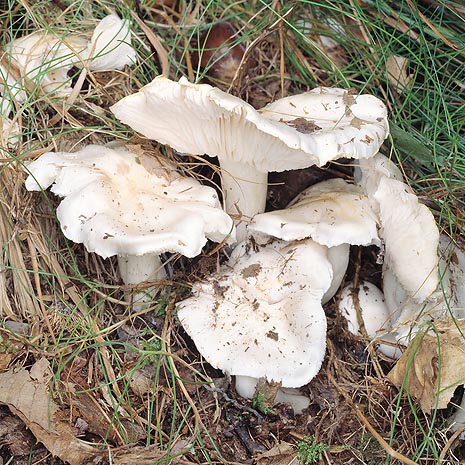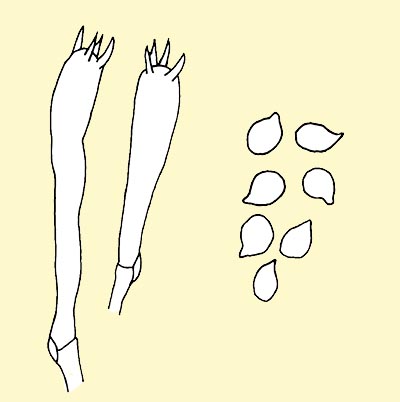
Text © Pierluigi Angeli

English translation by Mario Beltramini

Snow-white, silky cap, smell of flour, hazel-nut taste © Giuseppe Mazza
Family: Tricholomataceae R. Heim ex Pouzar (1983).
Tribe: Tricholomateae Singer.
Genus: Tricholoma (Fries) Staude.
Section: Equestria Konrad & Moublanc.
Tricholoma columbetta (Fries : Fries) Kummer (1871).
The name columbetta, small dove, comes from the Latin diminutive of “columba”, and refers to its white colour.
Description of the genus
The genus Trocholoma includes terrestrial fungi.
Cap mostly umbonated, with glabrous surface, fibrillose, pruinose, felted hairy or velvety. White or gray gills, rarely yellow, with entire edge; trimmed on the margin or trimmed with small tooth. More or less cylindroid stipe, at times with partial veil. It can be decorated with ornamentations, such as scales, squamae, fibrillae, etc.
Flesh mainly whitish, immutable, only rarely turning. The fungi belonging on this genus are homogenous, that is, with continuous flesh on the cap and the stipe, which separates with breakage of the same.
Description of the species
Cap: 6-12 cm, initially bell-shaped, then convex and finally flattened, irregular, undulated, with not much evident umbo; margin slightly curved, lobed, supple, thin, smooth. Cuticle separable, smooth, silky, with radial fibrillae, bright, just viscous with wet weather; white at the beginning, then with cream gradations especially on the disc, spotted of reddish-pink when ripe.
Hymenium: on an average, thick gills, adnate or trimmed on the margin and decurrent with small tooth, wide, sinuate, intercalated by variously long lamellulae, irregularly jagged edge; white, then whitish or cream.

Tricholoma columbetta basidia and spores © Pierluigi Angeli
Stipe: 6-8 x 1,5-3 cm, slender, cylindrical, straight, at times curved at the base, attenuated in low, fibrous, rigid; covered by longitudinal fibrillae, white on white background, which confer a silky looks, at times spotted of blue-green at the base.
Flesh: Not very thick, compact, firm, frail, fibrous on the stipe, unchangeable white. Slight smell of flour, taste of hazel-nut.
Habitat: Growing by the end of summer and in autumn mainly under broadleaf trees (beech, chestnut and oak), less frequently under conifers.
Edibility: Good edible.
Microscopy. Spores: ovoid, smooth, with only one guttula, minute hilar appendage, 5,5-7 × 4-5,5 µm. Basidia: clavate, cylindroid, tetrasporic, with joints to buckle, 29-42 × 7-8 µm. Gills texture formed by fascicled and thin hyphae without joints to buckle. Pileipellis formed by stretched, thin and fascicled hyphae, with rounded-blunt terminal cells, raised and without pigment.
Remarks. It is a fungus easily determinable if some of its characteristics are carefully observed: the candid white of all the carpophore, the silky cap (at times with some cream dot at the centre), the base of the stipe having often some blue-green dots.
It differentiates from the Tricholoma album (Schaeffer L.E. : Fries) Kummer, from the Tricholoma pseudoalbum M. Bon and from the Tricholoma inamoenum (Fries : Fries..) Gillet as these ones are white or whitish, they do not have a pleasant smell and do not have the characteristics previously cited.
Synonyms: Agaricus columbetta Fries; Gyrophila columbetta Quélet.
→ For general notions about Fungi please click here.
→ To appreciate the biodiversity of MUSHROOMS please click here.
